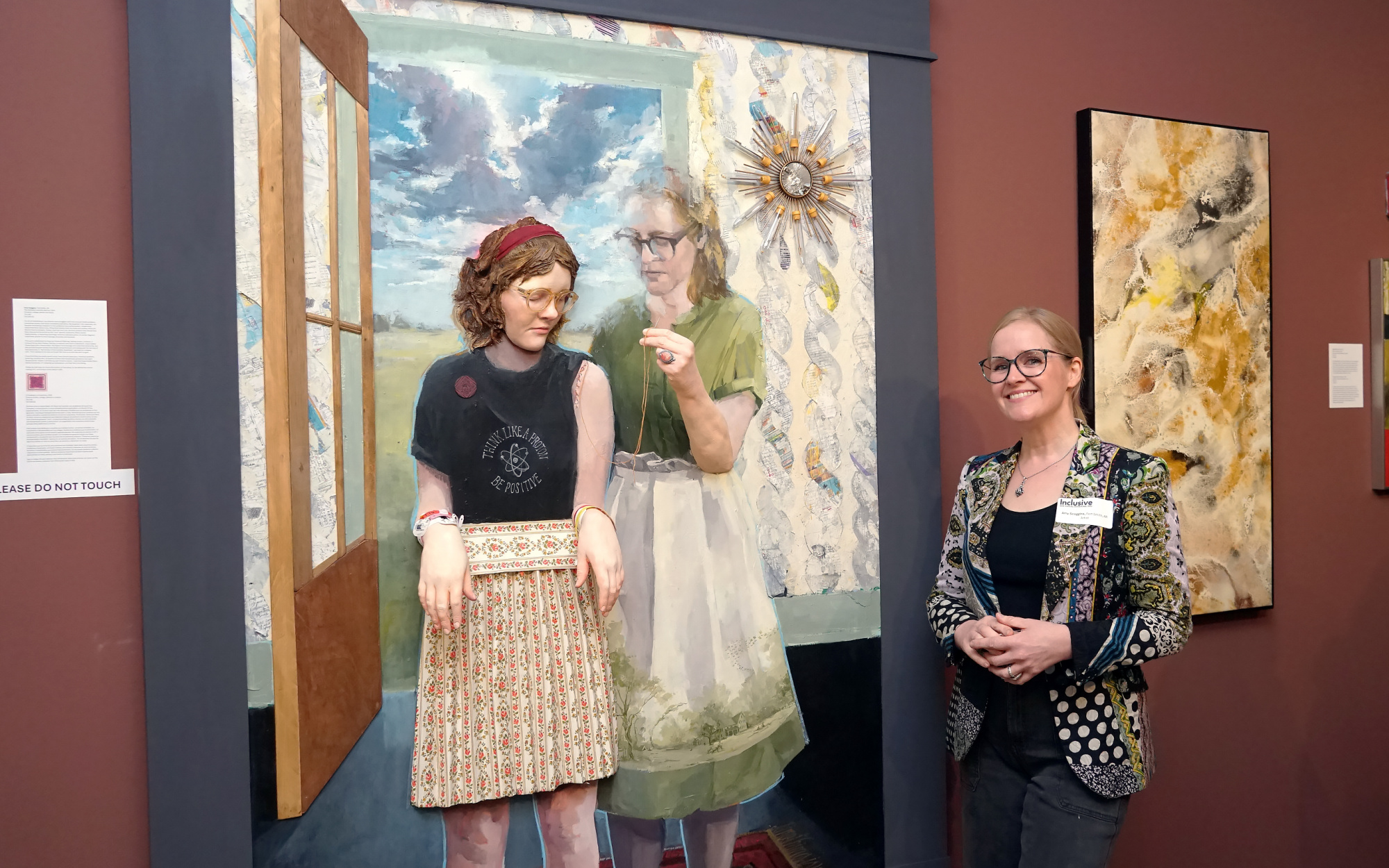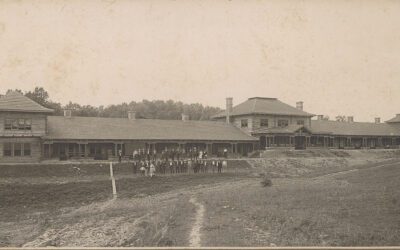Artist Amy Scoggins’ passion project has debuted in the Fort Smith Regional Art Museum’s Inclusive exhibition, marking the first stop for her traveling artwork, which raises awareness of Hypermobile Ehlers-Danlos Syndrome.
As the daughter of a painter, sixteen-year-old Ada Scoggins has grown up a muse to her mother, Amy, appearing in numerous sketches and portraits that typically don’t leave their house. But this summer, not only is Ada’s likeness on public display at the Fort Smith Regional Art Museum – her story of living with Hypermobile Ehlers-Danlos Syndrome is unfolding in a vulnerable way.
The RAM currently features artist Amy Scoggins’ work in a solo exhibition, Amy Scoggins: RECLAIMED, and in a group exhibition, Inclusive: RAM Annual Invitational 2024. Amy says that creating the pieces in RECLAIMED rekindled her artistic flame and gave her the confidence and platform to launch a project that brings awareness to Hypermobile Ehlers-Danlos Syndrome, the “invisible illness” plaguing her family and many others.
Since birth, Ada has suffered from a variety of ailments that persisted despite numerous treatment attempts and doctors’ promises that “she’ll be okay.” But Amy knew her child wasn’t “okay.”
She filled binders with notes chronicling Ada’s joint pain, stomach aches, brain fog, and other seemingly random discomforts. She tracked triggers and pleaded with doctors to dig deeper to find the root cause of her problems. “What that did for me as a mom is, for sixteen years, I thought, ‘What am I missing? What have I done wrong?’” Amy reflects, the words coming out shaky with emotion.
Ada says her mom “has a lot of emotions,” but perhaps that’s ideal for an advocate and an artist. “Her research has been obsessive,” Ada observes. “She’s constantly reading and looking at new medical papers and medical journals.”
Year after year, appointment after appointment, Amy and Ada grew exhausted and nearly gave up searching for a cause and cure until a friend pieced together the puzzling symptoms as those consistent with Hypermobile Ehlers-Danlos Syndrome. This friend encouraged Amy to investigate the inheritable connective tissue disorder, and a doctor confirmed the diagnosis in 2022.
“It broke open everything and catapulted us into half a dozen specialists’ offices. These new doctors listened and began to put together the pieces – some better than others,” Amy says. “Now my whole impetus for this body of work is trying to be that friend to somebody else – to spare some other little girl or momma the years of pain and illness.”
Creating “The Caretaker and the Warrior,” the piece now appearing in the RAM’s Inclusive exhibition, has allowed Amy to visualize and communicate Ada’s challenges to onlookers. It’s a three-dimensional painting over seven feet tall, featuring medical vials, a shattered mirror, a rug from their home, pulsating red lights, a hidden QR code, and scraps of Amy’s research notes.
Amy also taught herself the art of casting and sat with Ada for hours to create body casts of her daughter’s face, hands, and feet. “I wanted it to be our story and clearly a specific person… There’s something very humanizing about actually being able to see the pores on her nose and to look at her fingernails that are so realistically her and try to piece together what is going on here.”
“We had a lot of misfires with body casting,” Ada remembers, laughing at the memory of sitting like a statue while the goop slopped off her face.
Installing “The Caretaker and the Warrior” at the RAM felt like launching a mission into space: “Standing back and watching that unfold – I didn’t know what to anticipate, if all the pieces would work and if people would really respond to it as I had hoped,” Amy describes. “But it worked, and it was really beautiful. People were lining up, and crowding around, and going across the gallery and bringing other people to it.”
The 3D painting reminds people “to have compassion for the lives of the chronically ill and be mindful of invisible disabilities,” states RAM Gallery Manager Casey Seamans.
“It is clear from the multiple hospital bracelets hanging around the wrist of the ‘Warrior’ in the painting and the faint red glow around her head, that she is not well,” Seamans details. “From the mixed media, patterned wallpaper to the 3D face, hands, feet, and carpet almost floating off the canvas – ‘The Caretaker and the Warrior’ demands to be noticed.”
Amy’s work is financially supported by an Artists 360 grant, a Mid-America Arts Alliance program funded by the Walton Family Foundation. “The Caretaker and the Warrior” is the first of many “traveling, teaching pieces” in Amy’s developing exhibition, the Chronic Illness Initiative. She’s reaching out to hospitals, medical schools, and owners of community venues to discuss viewing opportunities in non-art spaces. Until then, the painting will remain at the RAM through August 25, 2024.
As Ada continues to ride the rollercoaster of life with Hypermobile EDS, Amy persists in researching the ups and downs of her daughter’s health. When Ada gets a cold, Amy feels relieved to catch it too, which means the new symptoms are common and temporary – not another EDS-related mystery to solve. “It’s been extremely frustrating, still,” Amy says. “It’s terrifying because our well-meaning doctors are still uninformed about it, and I’m still fighting at every appointment.”
Throughout their search for relief, the Scoggins family amassed support from a Facebook group for Arkansans with EDS. Dr. Thomas Lowder, the Director of Educational Research for the Baptist Health—University of Arkansas for Medical Sciences Graduate Medical Education Program, estimates there are 3,000 Arkansans living with EDS and says this patient population has difficulty obtaining a diagnosis and treatment.
“It’s not that this disease is so rare, but it is often misdiagnosed or not diagnosed at all,” Lowder states. “There are few physicians who specialize in identifying or managing this disease. This is not just a problem in Arkansas; this is a problem everywhere.”
The National Institute of Health’s Genetic and Rare Disease Information Center estimates nearly 200,000 people in the U.S. have Ada’s particular type of Hypermobile EDS.
When asked how she feels about her story going public, Ada shrugs and gives two thumbs up. She isn’t one to seek the spotlight and usually lets the art do the talking. She’ll discuss her health when warranted, but she’d rather talk about Star Trek, science and biology, or whatever witty sci-fi novel she’s reading.
Ada starts her senior year of high school in the fall, with plans to potentially move away for college. Amy sees these next twelve months as crucial for training Ada to advocate for herself. “Ada is making so much progress, physically and in her spirit,” she affirms.
Meanwhile, Amy stays motivated by her faith and guided by Bible verses like 2 Corinthians 1:3-4, which describes a “God of all comfort, who comforts us in all our troubles, so that we can comfort those in any trouble.”
“The Lord continues to rescue us by teaching us new things,” Amy reflects. Those revelations allow her to help the other caretakers and warriors persevere.
To learn more about Hypermobile Ehlers-Danlos Syndrome visit ehlers-danlos.com.
For updates on Amy’s work, go to scogginsart.com.
WORDS Andrea Smith
IMAGES courtesy of Amy Scoggins, Fort Smith Regional Art Museum, and Emilie Marston Photography




